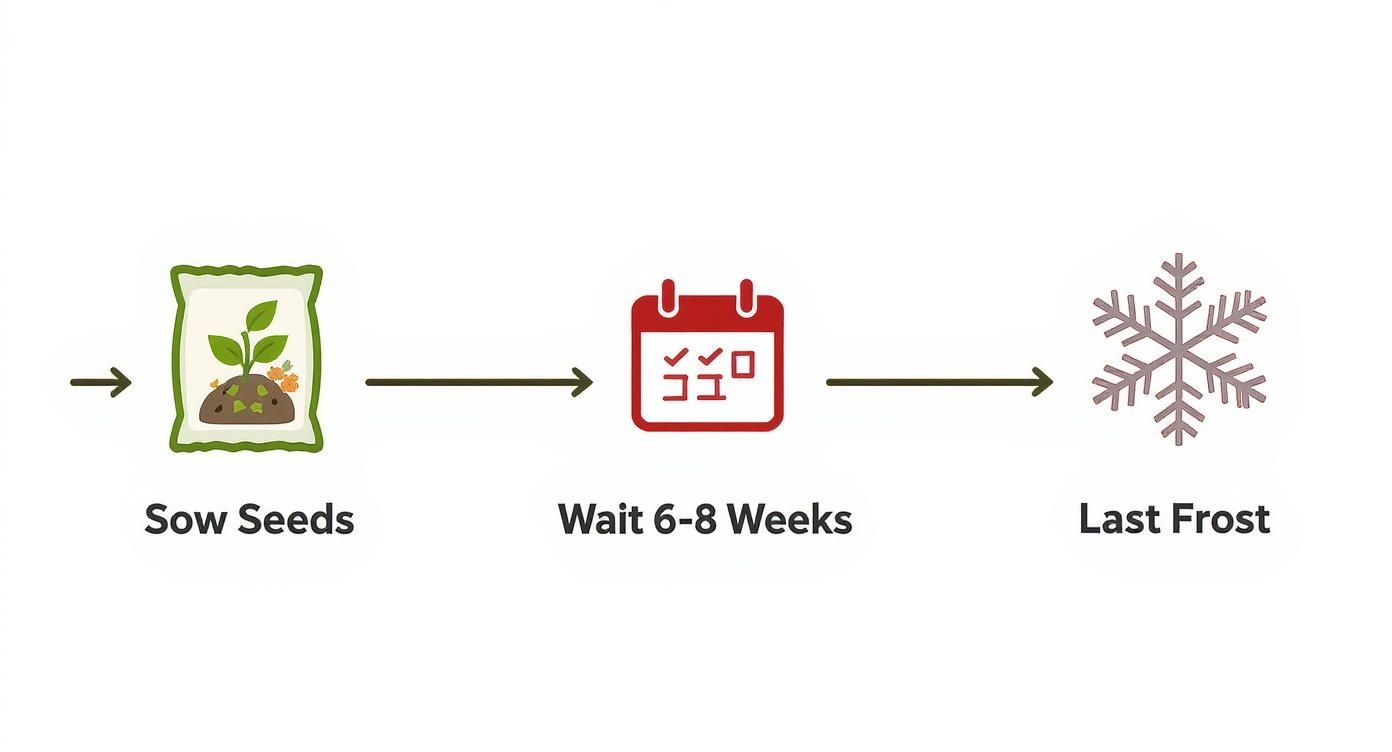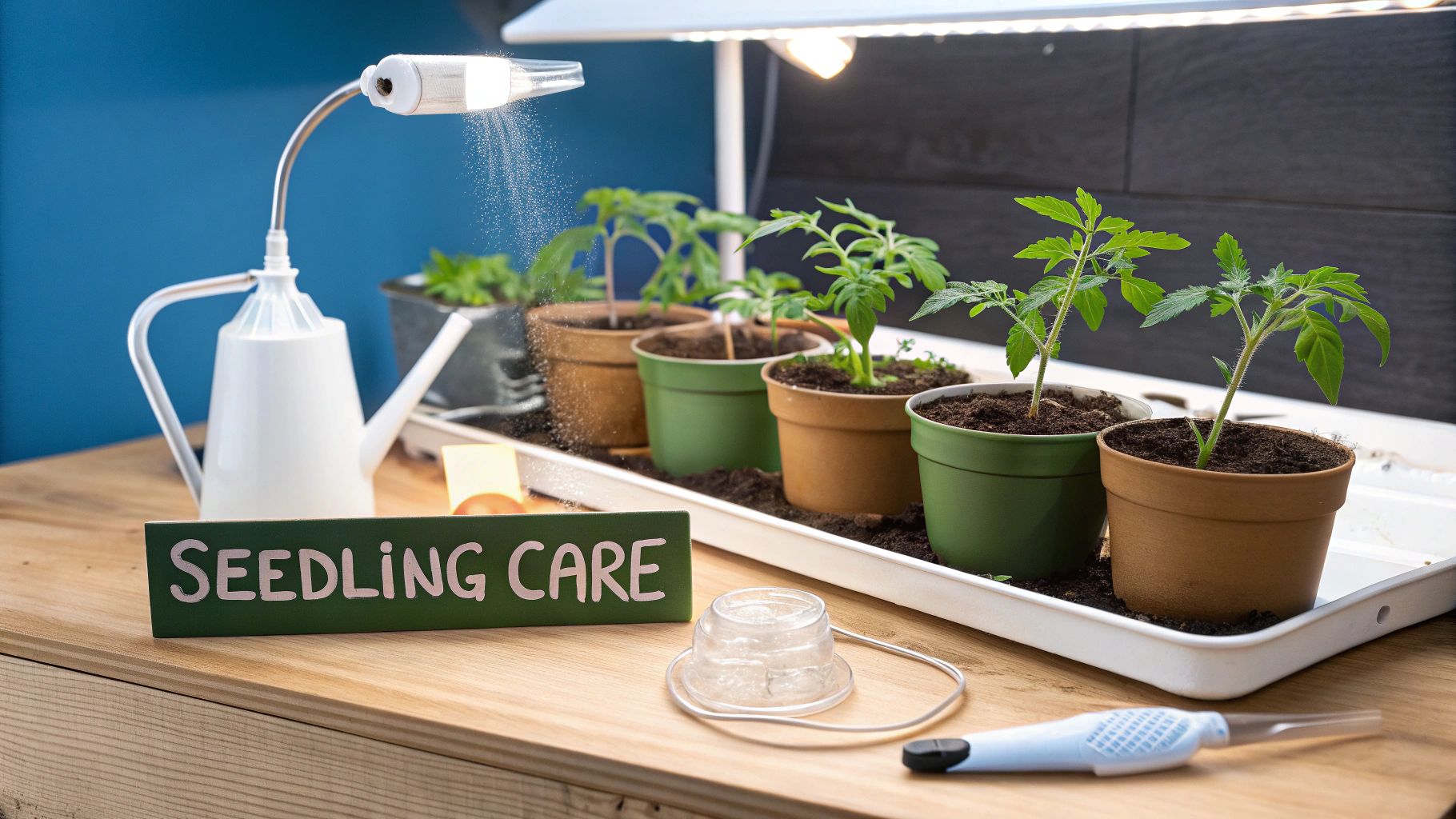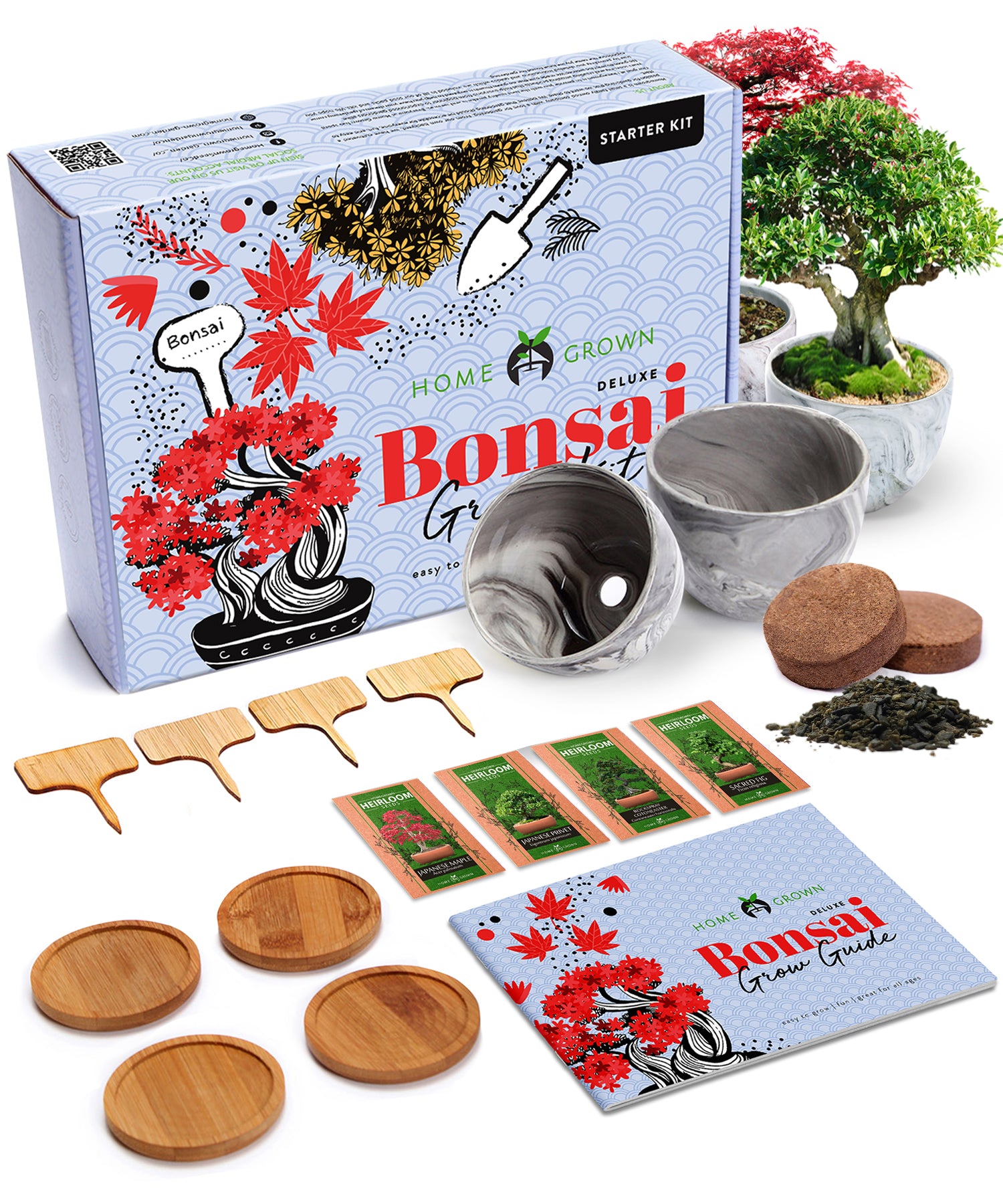
Getting your timing right is one of the biggest secrets to a truly amazing tomato harvest. The most trusted rule of thumb? Start your tomato seeds indoors 6-8 weeks before the average last frost date in your area. This simple strategy gives your tiny seedlings the protected head start they need to grow strong and sturdy before they ever face the great outdoors.
1. Master the 6-8 Week Rule for a Perfect Timeline
Think of this 6-8 week window as the sweet spot for gardeners everywhere. It's the ideal amount of time to get your plants from tiny seeds to vigorous young transplants, ready to thrive once the weather warms up. In fact, this method is so reliable that 70-80% of the world's commercial tomatoes begin their lives as seedlings in controlled indoor settings.
Giving your tomato plants this indoor head start is like letting them train in a gym before a big race—it builds strength and resilience for the challenges of the great outdoors.
To nail this, you just need two key pieces of information: your local last frost date and the right soil temperature for sprouting. We have a great resource that breaks down the ideal conditions, so be sure to check out our guide on the best seed germination temperature chart to get your seedlings the warmth they crave.
Here’s a simple table to help you visualize that 6-8 week countdown.
| Milestone | Timing Before Last Frost Date |
|---|---|
| Sow Seeds Indoors | 6-8 weeks |
| Germination & First Leaves | 5-7 weeks |
| "Potting Up" to Larger Containers | 3-4 weeks |
| Start "Hardening Off" | 1-2 weeks |
| Transplant Outdoors | 0 weeks (after all frost danger has passed) |
By following this timeline, you set your tomatoes up for success from day one, leading to a healthier, more productive season.
2. Decode Your Climate Zone for Sowing Dates
While the old "start seeds 6-8 weeks before the last frost" advice is a great starting point, your local climate zone is what truly calls the shots. There isn't one perfect date that works for everyone; the real secret to a great tomato harvest is learning to work with your specific environment.
For example, a gardener in a temperate climate like the UK or much of the US might get their seeds started indoors as early as January or February. But head to a much warmer region like India, and you'll find farmers often sow twice a year—once in March for a monsoon harvest and again in October for a winter crop. You can see just how much schedules vary by looking at these global tomato production insights on worldpopulationreview.com.
Think of it as a simple countdown. You're giving your seedlings a protected head start inside before they're strong enough to be planted out in the garden.

No matter where you live, that 6-8 week indoor growing period is pretty much non-negotiable. It's the critical time your plants need to build up the strength to survive—and thrive—once they're exposed to the great outdoors.
3. Choose Between Indoor vs. Outdoor Sowing

Where you sow your tomato seeds is just as important as when you do it. For the vast majority of gardeners, starting seeds indoors is the hands-down winner. Think of it as giving your baby plants a safe, cozy nursery to grow up in.
By starting them inside, you shield your delicate seedlings from wild weather swings, chilly nights, and common garden pests that are more than happy to make a meal out of them. This controlled environment gives them a crucial head start, resulting in stronger, more resilient plants and an earlier harvest. If you're looking for a deep dive, our guide on when to start seeds indoors will walk you through the process.
What about planting seeds directly in the garden? This is rarely the best approach for tomatoes. Direct sowing really only works if you live somewhere with a very long, consistently warm growing season. For everyone else, it’s a gamble.
Understanding the pros and cons here is key. Making the right choice gives your tomatoes the best possible start in life, setting you up for a season full of healthy growth and delicious, homegrown fruit.
4. Adjust Sowing Time Based on Tomato Variety
It absolutely does. Think of it this way: not all tomatoes are on the same schedule. The specific variety you’ve chosen is a major piece of the puzzle, and the secret is usually printed right on your seed packet.
Look for the "days to maturity". This number tells you roughly how long it takes for a seedling to grow into a plant that gives you your first ripe tomato. It's the plant's internal clock.
Some of those big, beautiful heirlooms—like a classic 'Brandywine'—are long-season varieties. They need every bit of that 6-8 week head start indoors to have enough time to produce before the season ends. On the flip side, you have quicker, more compact varieties like 'Early Girl' that mature faster. You can often get away with starting them a bit later and still get a great harvest.
This isn't just a home gardener's trick; it's a massive deal in the commercial world. Seed companies are constantly developing new hybrids to meet specific growing windows and market demands, which globally tops 180 million metric tons a year. You can get a sense of these global tomato seed market trends on imarcgroup.com.
Once you understand the "days to maturity" for your chosen plants, you can work backward from your last frost date and build a planting schedule that’s perfectly suited to your garden.
5. Nurture Your Seedlings in the First Few Weeks

Getting the seeds in the soil is just the beginning. Now comes the really rewarding part: nurturing those tiny seeds into strong, garden-ready plants. Getting this stage right is everything.
Keep Them Cozy and Bright
Your two biggest jobs are managing water and light. Keep the soil consistently moist, but be careful not to drown them. The goal is the texture of a wrung-out sponge, not a swampy mess.
Light is just as important. Your seedlings are hungry for it, needing at least 12-16 hours of bright light every day. While a south-facing window can sometimes do the trick, a simple grow light is your best bet to prevent leggy, weak stems and encourage stout, healthy growth.
The secret to quick germination is warmth. Most tomato varieties will sprout fastest when the soil temperature is kept in that sweet spot between 75-85°F (24-29°C). A heat mat can make a world of difference here.
Give Them Room to Breathe and Grow
Don't forget about fresh air. Good air circulation is key to preventing "damping-off," a fungal disease that can quickly wipe out a tray of seedlings. A small fan on a low setting, pointed away from the plants, will create a gentle breeze that strengthens stems and keeps things fresh.
As your little plants grow their first true leaves and get bigger, they'll need more room for their roots. This is when you'll "pot up," carefully moving each seedling into its own, slightly larger container. This step gives them the space they need to develop a robust root system, setting them up for a successful life in the garden.
6. Follow a "Hardening Off" Schedule

Before your tender, indoor-grown seedlings can make the big move to the garden, they need to go through a bit of boot camp. This essential process is called hardening off, and trust me, skipping this step is a recipe for disaster. It's probably the most common mistake new gardeners make.
Think of your seedlings like newborns who have spent their whole lives in a climate-controlled nursery. You wouldn't suddenly expose them to the harsh realities of the outside world, would you? The same goes for your plants. They need a gentle, gradual introduction to things like direct sun, wind, and those wild temperature swings.
This slow-and-steady exposure is key to preventing transplant shock, which can stunt or even kill your young tomatoes. It toughens them up, thickens their cell walls, and prepares them to not just survive, but truly thrive in their new home. For a complete guide, check out my deep dive into how to harden off seedlings.
A Sample 7-Day Hardening Off Schedule
Here's a sample schedule to give you a clear picture of how this works. The goal is to slowly increase exposure time each day, always keeping an eye on how your plants are reacting.
| Day | Action Required | Key Observation |
|---|---|---|
| Day 1 | Place seedlings in a shady, protected spot outdoors for 1-2 hours. | Watch for any signs of wilting. Bring them in immediately if they look stressed. |
| Day 2 | Increase time to 2-3 hours in the same shady spot. | Leaves should look strong. A little wind exposure is good for building stem strength. |
| Day 3 | Move them into morning sun for 1 hour, then back to shade for 2-3 hours. | Sunburn is your enemy! Look for white or bleached spots on the leaves. |
| Day 4 | Increase direct sun time to 2-3 hours, with a total of 4-5 hours outside. | The stems should be getting sturdier and less "leggy." |
| Day 5 | Give them 4-5 hours of direct sun. | Seedlings should look robust. Reduce watering slightly to help them toughen up. |
| Day 6 | Leave them out for most of the day, including some afternoon sun. | Check the soil moisture; they'll dry out faster outdoors. |
| Day 7 | Let them stay outside all day and, if temps are above 50°F (10°C), overnight. | Congratulations! They are now ready to be planted in the garden. |
Remember, this is just a template! If you hit a particularly windy or scorching hot day, it's perfectly fine to keep the seedlings in a more protected spot or even skip a day. Listening to your plants is the most important part of the process.
7. Get Answers to Your Top Tomato Sowing Questions
Let's dig into some of the questions I hear most often from gardeners about starting tomato seeds. Getting the timing right can feel tricky, but with a few key pointers, you'll be set up for a fantastic harvest.
Can I Plant Tomato Seeds Directly in the Garden?
Technically, yes, you can... but I almost never recommend it unless you live somewhere with a very long and reliably warm growing season.
Think of it this way: starting seeds indoors is like giving your baby plants a safe, controlled nursery. It protects them from surprise cold snaps, hungry pests, and heavy spring rains. This protected start gives them the strength they need to flourish once they move outside, leading to a much better and more reliable harvest.
What Is the Latest I Can Sow Seeds?
This is a great question, and the answer is all about working backward from your first fall frost.
Grab your seed packet and find the "days to maturity" number. Then, find your area's average first frost date online. Count back from that frost date by the number of days to maturity, and then subtract another month just to give yourself a decent harvest window. Sowing any later than that is really pushing your luck with Mother Nature.
Why Are My Seedlings So Tall and Skinny?
Ah, the classic "leggy" seedling problem! If your seedlings look like they're stretching for the sky, it's a cry for help. They're desperately seeking more light.
This is a simple fix. Your seedlings need intense, direct light. Either move them to a much sunnier, south-facing window or, even better, get a grow light. You'll want to position the light just a few inches above the tops of the plants for 12-16 hours a day. They'll stop stretching and start growing stout and strong.
Find the perfect heirloom seeds and get all the support you need at Homegrown Garden. Start your journey at https://www.homegrown-garden.com today.




